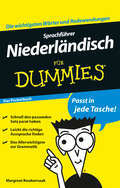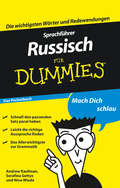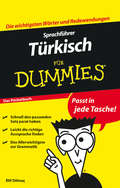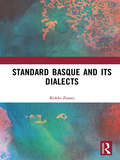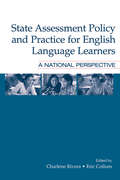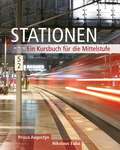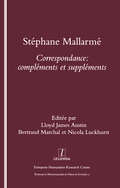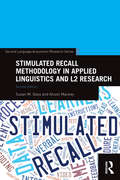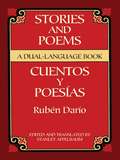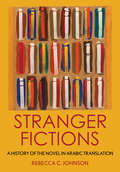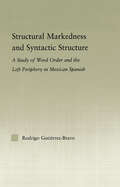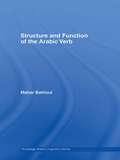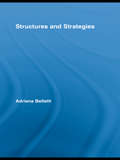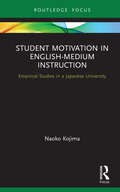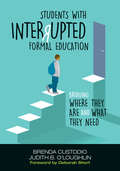- Table View
- List View
Sprachführer Niederländisch für Dummies Das Pocketbuch (Für Dummies)
by Margreet KwakernaakMit diesem Büchlein sind Sie für kurze Gespräche auf Niederländisch gerüstet: ob Sie im Supermarket in Den Haag einkaufen, in Amsterdam in einem Restaurant eine Mahlzeit bestellen oder in Scheveningen ein Hotel reservieren. Hier finden Sie die passenden Sätze für die jeweilige Situation. Ganz nebenbei erfahren Sie das Wichtigste über die niederländische Grammatik und bekommen viele Tipps für die richtige Aussprache.
Sprachführer Russisch für Dummies Das Pocketbuch (Für Dummies)
by Andrew Kaufman Serafima Gettys Nina Wieda"Sprachführer Russisch für Dummies" bietet einen schnellen Überblick über die wichtigsten Wörter und Redewendungen für den Alltag. Jedes Kapitel beschäftigt sich mit einer Alltagssituation: So haben Sie schnell die passenden Sätze parat, wenn Sie sich jemandem vorstellen, im Restaurant bestellen oder nach einer Wegbeschreibung fragen. Dazu bekommen Sie eine kurze Einführung in die Grammatik und Aussprache des Russischen.
Sprachführer Türkisch für Dummies Das Pocketbuch (Für Dummies)
by Elif DilmaçMit diesem Büchlein sind Sie für kurze Gespräche auf Türkisch gerüstet: ob Sie in Antalya im Supermarkt einkaufen, in Istanbul im Basar feilschen oder in Izmir im Restaurant etwas bestellen. Hier finden Sie die passenden Sätze für die jeweilige Situation. Ganz nebenbei erfahren Sie das Wichtigste über die türkische Grammatik und bekommen viele Tipps für die richtige Aussprache.
Standard Arabic: An Advanced Course
by James Dickins Janet C. E. WatsonThis course is designed for students who have completed a first-level course in Arabic and wish to pursue the subject to degree level. It aims to develop thoroughly the four basic language skills of reading, writing, speaking and listening, making extensive use of authentic Arabic materials. Each of the twenty chapters is based around a particular topic relating to the culture, history, politics, geography or society of the Arab Middle East, to give students an insight into important aspects of the region. This topic-based approach allows students to tackle vocabulary and structures in a coherent and concentrated manner. Each chapter contains materials for translation into and from Arabic, aural texts, précis passages, suggested oral discussion topics, and a variety of exercises including comprehension in English and Arabic. Accompanying cassettes and a teacher's handbook are available.
Standard Basque and Its Dialects
by Koldo ZuazoThe origins of Basque dialects, a highly disputed area of research in Basque studies, are examined. The author, the foremost expert on Basque dialects, traces their emergence to medieval times, using: a) the profusion of features common to all dialects: b) the large number of innovations common to all dialects; and c) the fact that the only truly divergent dialects are the western and Souletin ones. In contrast, the three central dialects differ in far fewer and less important respects. The main contribution of Standard Basque and Its Dialects to the scholarly debate about the formation of Basque is that it identifies the nuclei from which the current dialects almost certainly emerged. The book explains the points of view that Basque speakers have upheld concerning their dialects, the formation of provincial standards starting in the eighteenth century, and the launch of Standard Basque in the second half of the twentieth century.
State Assessment Policy and Practice for English Language Learners: A National Perspective
by Charlene Rivera Eric CollumState Assessment Policy and Practice for English Language Learners presents three significant studies, each examining a different aspect of states' strategies for including English language learners in state assessments. *an Analysis of State Assessment Policies Regarding Accommodations for English Language Learners;*a Survey and Description of Test Translation Practices; and *an Examination of State Practices for Reporting Participation and Performance of English Language Learners in State Assessments.With the rise in population of English language learners and the subsequent stepped-up legislative focus on this student population over the past decade, states have been challenged to include English language learners in state assessment programs. Until now, the little data available on states' policies and practices for meeting this challenge has been embedded in various reports and professional journals and scattered across the Internet. This volume offers, for the first time, a focused examination of states' assessment policies and practices regarding English language learners. The three studies were supported by OELA, the U.S. Department of Education's Office of English Language Acquisition, Language Enhancement, and Academic Achievement for Limited English Proficient Students.State Assessment Policy and Practice for English Language Learners is of interest to researchers and professionals involved with the assessment of English language learners; state- and district-level policy makers; and academics, teacher educators, and graduate students in a number of fields, including educational and psychological assessment, testing and measurement, bilingual education, English as a second language, and second language acquisition.
State-Building and Multilingual Education in Africa
by Ericka A. AlbaughHow do governments in Africa make decisions about language? What does language have to do with state-building, and what impact might it have on democracy? This manuscript provides a longue durée explanation for policies toward language in Africa, taking the reader through colonial, independence, and contemporary periods. It explains the growing trend toward the use of multiple languages in education as result of new opportunities and incentives. The opportunities incorporate ideational relationships with former colonizers as well as the work of language NGOs on the ground. The incentives relate to the current requirements of democratic institutions, and the strategies leaders devise to win elections within these constraints. By contrasting the environment faced by African leaders with that faced by European state-builders, it explains the weakness of education and limited spread of standard languages on the continent. The work combines constructivist understanding about changing preferences with realist insights about the strategies leaders employ to maintain power.
Stationen: Ein Kursbuch für die Mittelstufe
by Prisca Augustyn Nikolaus EubaTake a tour of the German-speaking world, with STATIONEN: EIN KURSBUCH F SR DIE MITTELSTUFE, an innovative intermediate German program. Combining engaging cultural topics with authentic readings, this text gives you the basis to develop insight into German life today and proficiency with the language. Each chapter of STATIONEN revolves around a city or region in the German-speaking world, inviting you to make connections and comparisons between chapters, topics, and cultural issues. In addition, the accompanying video component (available on DVD) contains footage of videoblogs from eleven cities in Germany, Austria, and Switzerland that complement the text and offer fascinating glimpses of contemporary German culture. These snapshots of everyday life pair interview clips with images of public spaces to move you beyond the realm of ordinary language instruction and into the scenarios and situations that reflect your real-world needs as a developing German speaker.
Stephane Mallarme: Correspondence - Complements et Supplements
by Nicola Luckhurst Lloyd James Austin Bertrand Marchal"This collection of Stephane Mallarme's letters is an indispensable companion to the 'complete' correspondence published by Gallimard in eleven volumes (1959-85). The collection comprises 143 letters, dating from 1863 to 1898. Many are previously unpublished, others are published in their entirety for the first time. Not only is the life and work of the poet revealed through his letter writing, but Austin's editorial notes also include the replies of Mallarme's editors and fellow writers. A vivid dialogue emerges between the poet and his contemporaries."
Stimulated Recall Methodology in Applied Linguistics and L2 Research (Second Language Acquisition Research Series)
by Alison Mackey Susan M. GassStimulated Recall Methodology in Applied Linguistics and L2 Research provides researchers and students in second language acquisition and applied linguistics with the only how-to guide on using stimulated recalls in their research practice. This new edition expands on the scope of the previous edition, walking readers step-by-step through a range of studies in applied linguistics in order to demonstrate the history of stimulated recalls and their efficacy as a data collection tool. With its exclusive focus on stimulated recalls, coverage of the most up-to-date research studies, and pedagogically rich text design, Stimulated Recall Methodology in Applied Linguistics and L2 Research supplies researchers and students with the practical skills to elicit richer data in their own research.
Stories and Poems/Cuentos y Poesías: A Dual-Language Book
by Rubén Darío Stanley AppelbaumNicaraguan poet and essayist Darío (the pen name of Félix Rubén García Sarmiento) is considered the high priest of the modernismo school of literature. This volume contains a rich selection of his best poems and stories from Azul (Blue), Prosas profanas (Worldly Hymns), and others. Accurate English translations appear on the facing pages.
Stories from One Thousand and One Nights: For Intermediate and Advanced Students of Arabic
by Ghada BualuanSpecially designed for students of Arabic, this textbook presents a selection of authentic Arabian Night stories in simplified language providing learners of Modern Standard Arabic access to this classic of Arabic literature. Each story is fully supported by a range of comprehension, vocabulary-building, grammar reinforcement activities and exercises as well as an audio version of the story, which can be accessed at www.routledge.com/9781138948228. Ideal for class-use or self-study, students will enhance their reading, listening, and writing skills while developing the ability to analyze literary texts, reason critically, and broaden their understanding and appreciation of different layers of Arab culture.
Stories in Red and Black
by Elizabeth Hill BooneThe Aztecs and Mixtecs of ancient Mexico recorded their histories pictorially in images painted on hide, paper, and cloth. The tradition of painting history continued even after the Spanish Conquest, as the Spaniards accepted the pictorial histories as valid records of the past. Five Pre-Columbian and some 150 early colonial painted histories survive today. This copiously illustrated book offers the first comprehensive analysis of the Mexican painted history as an intellectual, documentary, and pictorial genre. Elizabeth Hill Boone explores how the Mexican historians conceptualized and painted their past and introduces the major pictorial records: the Aztec annals and cartographic histories and the Mixtec screenfolds and lienzos. Boone focuses her analysis on the kinds of stories told in the histories and on how the manuscripts work pictorially to encode, organize, and preserve these narratives. This twofold investigation broadens our understanding of how preconquest Mexicans used pictographic history for political and social ends. It also demonstrates how graphic writing systems created a broadly understood visual "language" that communicated effectively across ethnic and linguistic boundaries.
Story of Love in Solitude
by Roger Lewinter Rachel CareauA notable discovery of a truly original voice Several stories inhabit Roger Lewinter's first small book to appear in English, Story of Love in Solitude. Each story takes the form of a loop: a spider who won't stop returning; camellias that flourish and then die; dying parents whose presence is always yet felt; turning again and again to work on Rilke translations; a younger man whom the narrator sees each week at the Geneva street markets. All the tales touch on the possibility, the open possibility of love--a loop without end. Lewinter's short fictional works are at once prose poems and a form of dreaming; they are akin to the great French tradition of things sparking emotions and emotions sparking things--part Sarraute, part Robbe-Grillet, part Perec. Plot is not really the point of his meditative works. Lewinter concerns himself more with perception, apperception, and sudden inflections of grace: loss and beauty meet in an explosion of joy, which becomes, "in its brilliance, a means of transmittal."
Strange Cocktail: Translation and the Making of Modern Hebrew Poetry (Michigan Studies In Comparative Jewish Cultures)
by Adriana X. JacobsFor centuries, poets have turned to translation for creative inspiration. Through and in translation, poets have introduced new poetic styles, languages, and forms into their own writing, sometimes changing the course of literary history in the process. Strange Cocktail is the first comprehensive study of this phenomenon in modern Hebrew literature of the late nineteenth century to the present day. Its chapters on Esther Raab, Leah Goldberg, Avot Yeshurun, and Harold Schimmel offer close readings that examine the distinct poetics of translation that emerge from reciprocal practices of writing and translating. Working in a minor literary vernacular, the translation strategies that these poets employed allowed them to create and participate in transnational and multilingual poetic networks. Strange Cocktail thereby advances a comparative and multilingual reframing of modern Hebrew literature that considers how canons change and are undone when translation occupies a central position—how lines of influence and affiliation are redrawn and literary historiographies are revised when the work of translation occupies the same status as an original text, when translating and writing go hand in hand.
Stranger Fictions: A History of the Novel in Arabic Translation
by Rebecca C. JohnsonZaynab, first published in 1913, is widely cited as the first Arabic novel, yet the previous eight decades saw hundreds of novels translated into Arabic from English and French. This vast literary corpus influenced generations of Arab writers but has, until now, been considered a curious footnote in the genre's history. Incorporating these works into the history of the Arabic novel, Stranger Fictions offers a transformative new account of modern Arabic literature, world literature, and the novel.Rebecca C. Johnson rewrites the history of the global circulation of the novel by moving Arabic literature from the margins of comparative literature to its center. Considering the wide range of nineteenth- and early twentieth-century translation practices—including "bad" translation, mistranslation, and pseudotranslation—Johnson argues that Arabic translators did far more than copy European works; they authored new versions of them, producing sophisticated theorizations of the genre. These translations and the reading practices they precipitated form the conceptual and practical foundations of Arab literary modernity, necessitating an overhaul of our notions of translation, cultural exchange, and the global.Examining nearly a century of translations published in Beirut, Cairo, Malta, Paris, London, and New York, from Qiat Rūbinun Kurūzī (The story of Robinson Crusoe) in 1835 to pastiched crime stories in early twentieth-century Egyptian magazines, Johnson shows how translators theorized the Arab world not as Europe's periphery but as an alternative center in a globalized network. Stranger Fictions affirms the central place of (mis)translation in both the history of the novel in Arabic and the novel as a transnational form itself.
Structural Markedness and Syntactic Structure: A Study of Word Order and the Left Periphery in Mexican Spanish
by Rodrigo Gutiérrez-BravoFirst Published in 2006. Routledge is an imprint of Taylor & Francis, an informa company.
Structure and Function of the Arabic Verb (Routledge Arabic Linguistics Series)
by Maher BahloulStructure and Function of the Arabic Verb is a corpus-based study that unveils the morpho-syntax and the semantics of the Arabic verb. Approaches to verbal grammatical categories - the constituents of verbal systems - often rely on either semantic-pragmatic or syntactic analyses. This research bridges the gap between these two distinct approaches through a detailed analysis of Taxis, Aspect, Tense and Modality in Standard Arabic. This is accomplished by showing, firstly, some basic theoretical concerns shared by both schools of thought, and, secondly, the extent to which semantic structures and invariant meanings mirror syntactic representations. Maher Bahloul’s findings also indicate that the basic constituents of the verbal system in Arabic, namely the Perfect and the Imperfect, are systematically differentiated through their invariant semantic features in a markedness relation. Finally, this study suggests that the syntactic derivation of verbal and nominal clauses are sensitive to whether or not verbal categories are specified for their feature values, providing therefore a principled explanation to a long-standing debate. This reader friendly book will appeal to both specialists and students of Arabic linguistics, language and syntax.
Structures and Strategies (Routledge Leading Linguists)
by Adriana BellettiFollowing crucial insights on the functional structure of the clause and recent developments within the cartographic projects and minimalism, this book addresses various central themes in Italian and Romance syntax ranging from verb syntax and the syntax of verb-related phenomena of agreement and cliticization, to word order issues and their status in discourse contexts. It illustrates a research program where the basic formal components of grammar, the rich cartographic syntactic structures, are directly implicated in morphosyntactic computations proper as well as in the articulation of discourse strategies.
Student Motivation in English-Medium Instruction: Empirical Studies in a Japanese University (Routledge Focus on English-Medium Instruction in Higher Education)
by Naoko KojimaThis book explores Japanese students’ learning experiences and challenges in English medium instruction (EMI) from motivational perspectives. Using self-determination theory (SDT) as the framework, the first part reveals a lack of the three psychological needs of SDT (autonomy, competence, relatedness) that cause loss of students’ initial interest in learning English language and content. The author outlines pedagogical interventions that can be implemented in order to make the learning environment better. The second half of the book shows the effects these interventions had on the fulfillment of the three psychological needs, especially perceived relatedness and autonomy. In conclusion, the author focuses on the importance of listening to Japanese students’ voices and building a community that can motivate students, thus maximizing the pedagogical effectiveness of EMI. This volume will be useful to anyone involved in motivation, language learning or EMI research, pedagogy or practice.
Student-Centered Approaches to Russian Language Teaching: Insights, Strategies, and Adaptations (Routledge Russian Language Pedagogy and Research)
by Svetlana V. Nuss Cynthia L. MartinStudent-Centered Approaches to Russian Language Teaching looks at how the field of Russian language pedagogy has evolved in recent years due to advances in technology along with shifts in attitudes to language pedagogy, and how the pandemic has compounded and accelerated these changes. This edited collection brings together different perspectives from the field of Russian language pedagogy. With pedagogical conversations now centered around students and their needs, as well as the evolving role of the teacher in the 21st century, this volume highlights the diverse ways in which instructional practices have evolved, making curriculum and assessment more student-centered and Russian language learning more engaging. The collection will be of interest to current and future instructors of Russian as a foreign or additional language who wish to diversify their instruction, as well as students of Russian language pedagogy and second language learning and teaching.
Students With Interrupted Formal Education: Bridging Where They Are and What They Need
by Brenda K. Custodio Judith B. O′LoughlinNew hope for our most vulnerable English learners "One of the guiding principles of effective English language teaching is for educators to know their students. And that in a nutshell captures the value of this book. . . . The compassion that Custodio and O’Loughlin feel for our SIFE students, the commitment they have to educating them well, and the comprehension they have of the assets these learners bring to the classroom are evident in the writing, tools, and vignettes they share." -Deborah J. Short Under the best of circumstances, the academic demands of today’s classrooms can be daunting to our English learners. But for the tens of thousands of newly arrived students with interrupted formal education, even the social challenges can be outright overwhelming. Rely on this all-in-one guide from Brenda Custodio and Judith O’Loughlin for expert insight on how to build the skills these students need for success in school and beyond. Inside you’ll find Essential background on factors leading to interrupted education Specific focus on refugee children and Latino immigrants Guidance on building internal resilience for long-term social and emotional health Recommendations for creating supportive environments at the classroom, school, and district level About one thing, Brenda and Judith are absolutely convinced: our SIFE students can learn and make progress, often at a remarkable speed. But it’s up to us, their educators, to provide the time, attention, and a specific focus. Consider this book your first step forward.
Students With Interrupted Formal Education: Bridging Where They Are and What They Need
by Brenda K. Custodio Judith B. O′LoughlinNew hope for our most vulnerable English learners "One of the guiding principles of effective English language teaching is for educators to know their students. And that in a nutshell captures the value of this book. . . . The compassion that Custodio and O’Loughlin feel for our SIFE students, the commitment they have to educating them well, and the comprehension they have of the assets these learners bring to the classroom are evident in the writing, tools, and vignettes they share." -Deborah J. Short Under the best of circumstances, the academic demands of today’s classrooms can be daunting to our English learners. But for the tens of thousands of newly arrived students with interrupted formal education, even the social challenges can be outright overwhelming. Rely on this all-in-one guide from Brenda Custodio and Judith O’Loughlin for expert insight on how to build the skills these students need for success in school and beyond. Inside you’ll find Essential background on factors leading to interrupted education Specific focus on refugee children and Latino immigrants Guidance on building internal resilience for long-term social and emotional health Recommendations for creating supportive environments at the classroom, school, and district level About one thing, Brenda and Judith are absolutely convinced: our SIFE students can learn and make progress, often at a remarkable speed. But it’s up to us, their educators, to provide the time, attention, and a specific focus. Consider this book your first step forward.
Studies in Turkic and Mongolic Linguistics (Royal Asiatic Society Books)
by Gerard ClausonThis book, now back in print having been unavailable for many years, is one of the most important contributions to Turkic and Mongolic linguistics, and to the contentious 'Altaic theory'. Proponents of the theory hold that Turkish is part of the Altaic family, and that Turkish accordingly exists in parallel with Mongolic and Tungusic-Manchu. Whatever the truth of this theory, Gerard Clauson's erudite and vigorously expressed views, based as they were on a remarkable knowledge of the lexicon of the Altaic languages and his outstanding work in the field of Turkish lexicography, continues to command respect and deserve attention.
Studies in Vietnamese Historical Linguistics: Southeast and East Asian Contexts (Global Vietnam: Across Time, Space and Community)
by Trang Phan Tuan-Cuong Nguyen Masaaki ShimizuThis book facilitates constructive interdisciplinary dialogue among linguistics and philology specialists concerning various languages in Vietnam, East Asia, and Southeast Asia. The book’s principal objective is to investigate the interdisciplinary nature of language change, with a particular focus on analyzing the structural and socio-cultural components of the evolution of specific linguistic phenomena over time. The book concentrates on the five primary language families in the East and Southeast Asian linguistic arena, namely Austroasiatic, Tai-Kadai, Sino-Tibetan, Austronesian, and Hmong-Mien. In doing so, it develops understanding of the extent to which language change is the result of language-internal mechanisms, prolonged contact with other languages within the same linguistic area, and the surrounding socio-cultural milieu. Given that Vietnam presents a linguistic microcosm of the East and Southeast Asia region, the book is divided into two sections. The first centers on historical linguistics relating to major languages based in Vietnam, including Vietnamese and its significant neighbors, Tay and Nung. The subsequent section examines the transformations observable in other languages prevalent across East and Southeast Asia that are historically, typologically, and geographically related to languages from Vietnam, including Chinese, Formosan, and Philippine languages, as well as Hmongic languages. A product of a workshop sponsored by the Harvard Yenching Institute held at the Institute of Sino-Nom Studies, this book encompasses a significant contribution to the field of Vietnamese historical linguistics, which has been notably underexplored in academic research. It is relevant to linguists, philologists, historians, anthropologists, and cultural scholars interested in Vietnam in particular, and the Southeast and East Asian cultural and linguistic landscape at large.
